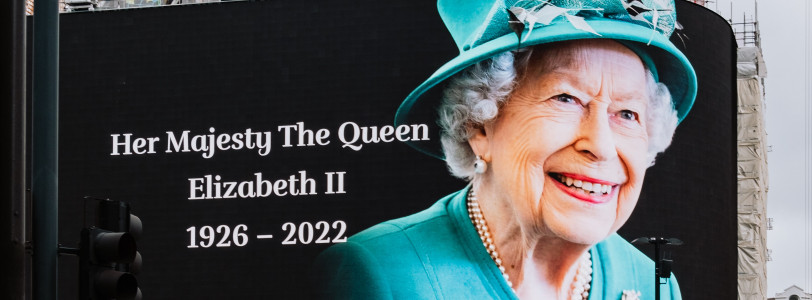Queen Elizabeth II’s reign in 1952 coincided with the emergence of “a distinct youth culture” that continued to develop and evolve over the 70 years she ruled for. What began as young people beginning to break free from the culture of their parents through Rock‘n’Roll and new fashion trends soon turned into a culture consumed by technology and social media, which have permanently altered the course of youth culture.
1950s
After World War 2, the concept of youth culture and the teenage lifestyle emerged rapidly, as marketing campaigns began specifically targeting teenagers. As youth culture became defined by an expanding generation gap between young people and their parents, the popularity of music, art and fashion that broke the norms and structures of parental culture skyrocketed.
Women’s clothing became colourful, adorned with poodles and bright colours, while men’s clothing embraced the rebellious nature of the decade, with simple looks of white t-shirts and black leather jackets. These fashion trends accompanied the rise of Rock‘n’Roll music from the US and television, and perhaps an increase in youths’ needs for materialistic items “that give immediate pleasure and little lasting use.” In the UK, the Queen focused fashion by encouraging the use of homegrown brands.
When it came to art, the 50s were a time of experimentation in Britain. Much like how youths were breaking free from prior social norms, many British artists began practising abstraction – “art containing simplified figures or objects.” However, during this time, youth culture was not looked upon with much favour.
1960s
As the 60s rolled in, as did hippy culture and a sharp clothing style that was inspired by Italian style. Arguably one of the most important changes in youth culture came when conscription – the requirement of young men to serve in the army – was abolished. With this came a rise in youth employment, which ultimately gave young people more money to spend on things like clothes, experiences – and drugs. This newfound freedom, combined with music groups like The Beatles, transformed youth culture, putting an emphasis on individuality and standing up for what you believe in.
The 60s also saw an increase in social tensions surrounding issues such as women’s rights and the hippy movement that further emphasised rebellion against social norms and expectations. Rock music became popular, as did folk music and songs containing political messages, all of which contributed to the idea of youths rebelling against the system.
1970s
Style and music in the 70s were greatly influenced by Jamaican culture, with some youths “adopting dreadlocks, reggae and Ethiopian colours as a symbolic form of opposition to a society in which they felt alienated and disaffected.”
This period also saw culture influenced by the skinhead image, American soul music, punk rock and glam rock – all of which helped create the image of rebellious, somewhat rowdy youths, who were not looked upon favourably. Punk rock served as an outlet for young people to challenge the notions of gender and sexuality, and also gave rise to the avant-garde art movement.
Additionally, social tensions were on the rise as Britain launched into a recession that left many youths unemployed or working in low-paying jobs. During the late 70s, disco was introduced and was reflected in both fashion and the creation of discotheques where young people frequented. Fashion also became more casual toward the end of the 70s as t-shirts and athleisure became popular.
In terms of technology, the TV only had three channels, and when the TV programming finished for the night, they played the national anthem in its entirety.
1980s
After the dark, rebellious decade of the 70s, the 80s brought a new, optimistic movement known as “new romantics.” With this came a decrease in popularity of rambunctious punk music and the introduction of New Wave and New Romantic Movement sounds. Unemployment levels remained high but young people saw significant social changes in gender norms, technological advances and a thriving youth culture.
The 1980s also saw the coining of the term “yuppies,” which referred to young people who worked hard and were wealthy but also considered entitled and arrogant. While women were involved in this movement, it was largely male dominated. It was an interesting time because technology was suddenly leaping ahead, home computers and mobile phones were introduced along with the internet in 1989, which served as the starting point for technology and connectivity as we know it today. The 80s also saw the introduction of basic gaming consoles like the gameboy, and this was the first time that young people started to stay inside more to play games. This also coincided with the introduction of TV programmes for young people.
Princess Diana influenced a lot of the fashion in the UK, and fashion became more diverse, colourful and quite casual in comparison to earlier decades; it became a way for young people to express themselves. Brand labels also became more prominent on clothing, as young people had more disposable income to spend on high-quality fashion.
The 80s were a time for standing up for yourselves; women and minorities started speaking up and fighting for equality, and this was aided by technological improvement that allowed people to connect with others who were like-minded.
1990s
The 90s saw the birth of Britpop and a transition from music rooted in rebellion. Music started to tackle real life issues and was less about love, more about reality. Toward the end of the decade, girl groups and boy bands became popular, largely targeted at teenage audiences. Music and fashion started to diversify further, as multiple genres and styles started to become popular. In the 60s you were either a mod or a rocker, for example, but in the 90s there was less desire to conform. The 90s also led to the rise of “girl power,” in part brought on by girl groups and other displays of female empowerment.
As the internet started to take off, the world seemed to get smaller, and gaming became more advanced. In the 80s, there were basic consoles and games, but in the 90s, graphics were improved and became more detailed, heralded by both the introduction of thePlaystation 1 in 1994 and Nintendo 64 in 1996. These consoles were also being produced much more rapidly during the 90s.
Ultimately, the 90s did not see the emergence of distinct youth culture as previous decades had. Youth culture was certainly still present but it was focused more around leisure time than the need for youths to express themselves through forms of rebellion.
2000s and 2010s
The 2000s were the decade when technology flourished and became more accessible to people across the world. Myspace, Facebook, Skype, Twitter and other social media platforms came into fruition and were embraced by young people who took advantage of the opportunity to connect with one another virtually. Similarly, the introduction of the iPod and iPhone made technology more portable and accessible as well. Technology significantly impacted youth culture during this time because of the speed at which music, fashion and culture trends could spread. In turn, this gave young people access to influences that they might not have come into contact with through the radio or mass media. The 2010s saw even more advances in technology and social media, which came to heavily define youth culture. Instagram, Snapchat, TikTok and a variety of other social media platforms were introduced and are still used today.
Much like the 90s, the noughties did not see a significant emergence of distinct youth cultures. Grime and Road Rap became popular, as did Drill, which according to some observers, was responsible for a rising tide of urban crime. Rising youth crime became of increasing concern during this time. Fashion continued to remain casual with bootcut jeans, cargo shorts and even tracksuits becoming popular for both genders to wear.
2020s
Modern youth culture is unlike that of any other era and is largely defined by social media, which has become a highlight reel of our lives. Technology continues to rapidly develop, with new and improved technologies like smartphones and laptops being introduced almost yearly.
Youths have, however, become more concerned with social, political and environmental issues, and the conversations surrounding these issues and a need for equality have grown drastically. Concern for environmental issues have led to an increase in thrifting and repurposing old clothes, which has brought back fashion trends and styles from past decades including flared trousers, blazers and mini skirts. “Vintage” has become the new new and buying sustainable fashion instead of fast fashion is an issue that has become prominent in defining youth culture, especially for girls and women.
Socially, the world has entered into a time where many young people champion equality, the abolishing of gender roles and norms and freedom for all people to have the rights they deserve. This has been largely reflected in youth culture – especially in the media, which is moving towards the promotion of equality and equal representation of all groups, although discrimination against these minority groups is unfortunately still present.
As the 2020s are still in their early years, we will have to wait and see what changes and advances come during King Charles III’s reign.







0 Comments